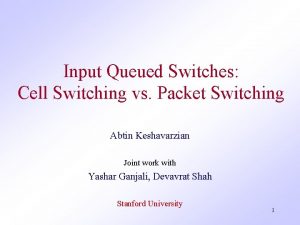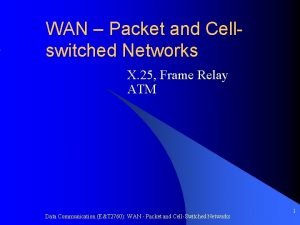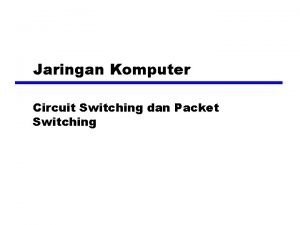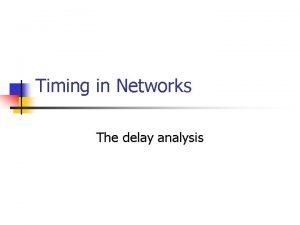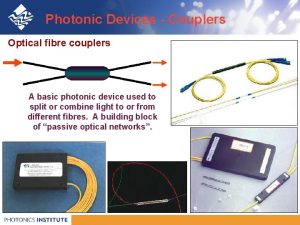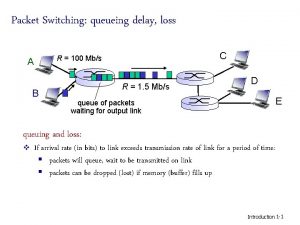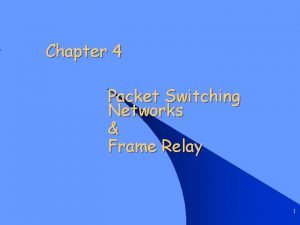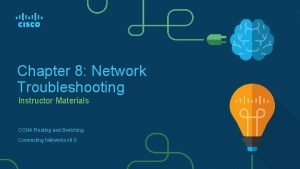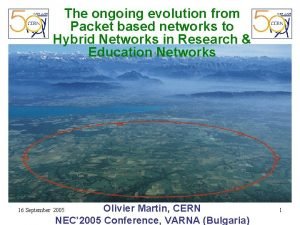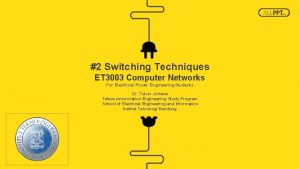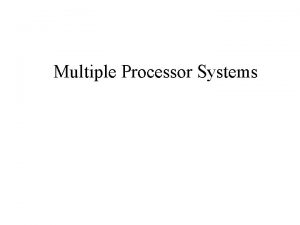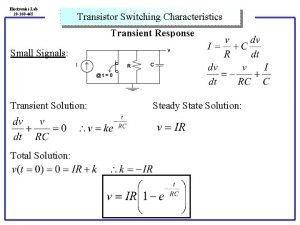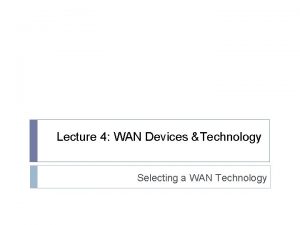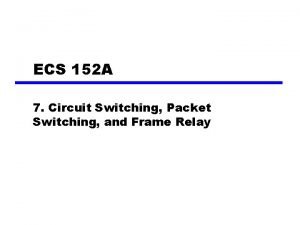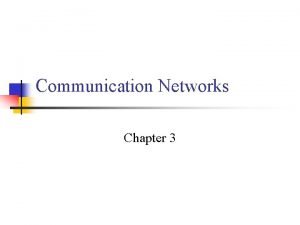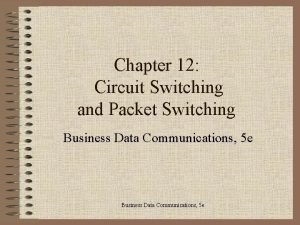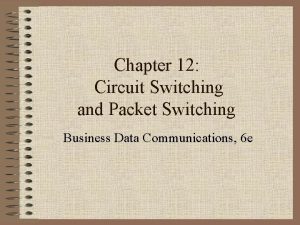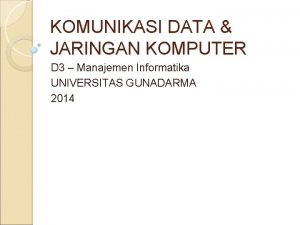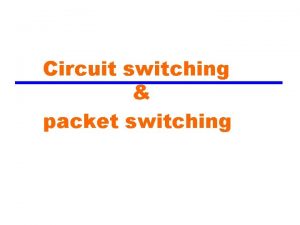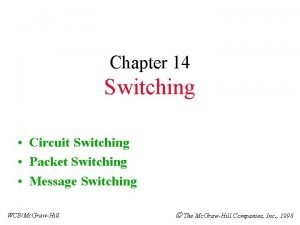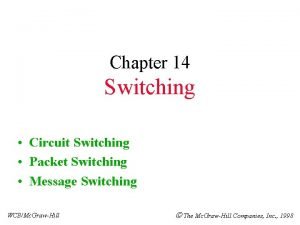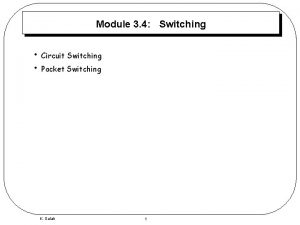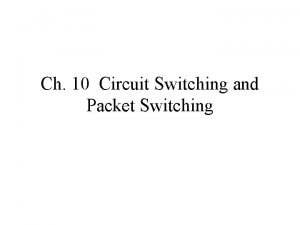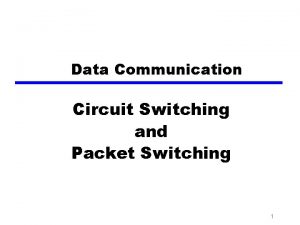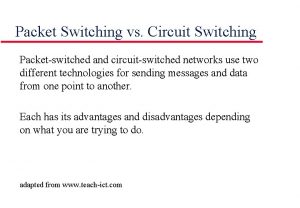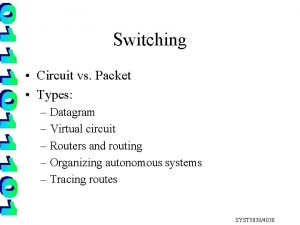Circuit Switching and Packet Switching Switching Networks Long



































- Slides: 35

Circuit Switching and Packet Switching

Switching Networks • Long distance transmission is typically done over a network of switched nodes • Nodes not concerned with content of data • End devices are stations —Computer, terminal, phone, etc. • Each station attaches to a node, and collection of nodes is a communications network

Switched network

Switched networks

CIRCUIT-SWITCHED NETWORKS It consists of a set of switches connected by physical links. A connection between two stations is a dedicated path made of one or more links. However, each connection uses only one dedicated channel on each link. Each link is normally divided into n channels by using FDM or TDM.

Figure 8. 3 A trivial circuit-switched network

Three phases • Setup phase • Data transfer • Teardown phase

Three phases End system A needs to communicate with M, A needs to request a connection to M that must be accepted by M, is called setup phase The dedicated path made of connected circuits is established, data transfer can take place Teardown phase: When one of the parties needs to disconnected, a signal is sent to each switch to release the resources

Note In circuit switching, the resources need to be reserved during the setup phase; the resources remain dedicated for the entire duration of data transfer until the teardown phase.

Example 8. 1 As a trivial example, let us use a circuit-switched network to connect eight telephones in a small area. Communication is through 4 -k. Hz voice channels. We assume that each link uses FDM to connect a maximum of two voice channels. The bandwidth of each link is then 8 k. Hz. Figure 8. 4 shows the situation. Telephone 1 is connected to telephone 7; 2 to 5; 3 to 8; and 4 to 6. Of course the situation may change when new connections are made. The switch controls the connections.

Circuit-switched network used in Example 8. 1 Figure 8. 4

Efficiency • Not as efficient as the other types • Resources are allocated during the entire duration of the connection • These resources are unavailable to other connections • Example: In telephone network, terminate they finished their communication when conservation • In computer n/w: computers are connected even if there is no activity for a long time

Delay in a circuit-switched network

Circuit-Switched Telephony Traditional PSTN Approach Signaling Class 5 Switch Typically analog “loop”, SS 7 Signaling Network Class 4 Switch Circuit-based Trunks voickb/s digital 64 Media e stream Data travels over a parallel (but separate) network Class 5 Switch

Data communication We need to send messages from one end system to another If the message is going to pass through a packet-switched network, it needs to be divided into packets of fixed or variable size The size of the packet is determined by the network and the governing protocol.

Packet switching • No resource allocation for a packet —It means no reserved BW & no scheduled processing time • Resources are allocated on demand —Allocation is done on a first come, first serve • When a switch receives a packet, no matter what is the source or destination —Packet must wait if there are other packets being processed

A datagram network. Figure with four switches (routers) 8. 7

DATAGRAM NETWORKS • Here, each packet is treated independently of all others. Even if a packet is part of multipacket transmission • It is normally done at the network layer • Packet travel different paths to reach their destination • Packets arrive at their destination out of order with different delays • Packetmay also be lost or dropped because of a lack of resources • It—It is a means connectionless network the switch does not keep info about the connection state —No setup or teardown phases

Routing table in a datagram network • Each switch has a routing table which is based on the destination address • Dynamic & updated periodically • Destination address and forwarding output ports are recorded in tables

Note A switch in a datagram network uses a routing table that is based on the destination address.

Note The destination address in the header of a packet in a datagram network remains the same during the entire journey of the packet. Efficiency is better than ckt switched network; resources are allocated only when there are packets to be transferred

Delay in a datagram network

VIRTUAL-CIRCUIT NETWORKS A virtual-circuit network is a cross between a circuit-switched network and a datagram network. It has some characteristics of both. There are setup, teardown, and data transfer phase like ckt Resources can be allocated during the setup phase, as in a ckt switched n/w, or on demand, as in a datagram In datagram, data are packetized and eack packet carries an address in the header In ckt switched n/w, all packets follow the same path established during the connection A virtual-ckt is implemented in data link layer, a ckt switch n/w in physical, datagram in network layer

Figure 8. 10 Virtual-circuit network

Addressing • Two types of address are involved: global and local Global Addressing • Source or destination needs to have global address —That can be Unique • Global address in virtual ckt is used only to create a virtual ckt identifier Virtual ckt identifier (VCI) • Identifier that is actually used for data transfer • A VCI, unlike a global, is a small number that has only switch scope • It is used by a frame between two switches • When a frame arrives at a switch, it has a VCI, when it leaves it has a different VCI

Virtual-circuit identifier Figure 8. 11

Data transfer phase • Frame from S to D , all switches need to have a table entry for this virtual ckt • It is active untill data transfer completes

Switch and tables in a virtual-circuit network

Source-to-destination data transfer in a virtual-circuit network

Setup phase • Source A needs to create a virtual ckt to B • 2 steps are required: —setup request —Acknowledgment

Figure 8. 14 Setup request in a virtual-circuit network

Figure 8. 15 Setup acknowledgment in a virtual-circuit network

Note In virtual-circuit switching, all packets belonging to the same source and destination travel the same path; but the packetsmay arrive at the destination with different delays if resource allocation is on demand.

Figure 8. 16 Delay in a virtual-circuit network

Note Switching at the data link layer in a switched WAN is normally implemented by using virtual-circuit techniques.
 Circuit switching vs packet switching vs message switching
Circuit switching vs packet switching vs message switching Circuit switching disadvantages
Circuit switching disadvantages Each packet is treated independently
Each packet is treated independently Cell switching vs packet switching
Cell switching vs packet switching Cell switching vs packet switching
Cell switching vs packet switching Difference between virtual and datagram circuit
Difference between virtual and datagram circuit Long and short
Long and short Once upon a time, there lived
Once upon a time, there lived X 25 wan
X 25 wan Pengertian packet switching
Pengertian packet switching Principles of packet switching
Principles of packet switching Timing datagram
Timing datagram Grating couplers wikipedia
Grating couplers wikipedia Dnodal
Dnodal Optical packet switching
Optical packet switching Frame relay packet switching
Frame relay packet switching Packet switching principles
Packet switching principles Packet tracer - troubleshoot enterprise networks
Packet tracer - troubleshoot enterprise networks Packet-based networks
Packet-based networks Switching in data link layer
Switching in data link layer Switching techniques in computer networks
Switching techniques in computer networks Cell switching in computer networks
Cell switching in computer networks Uma multiprocessors using multistage switching networks
Uma multiprocessors using multistage switching networks Transistor switching networks
Transistor switching networks Basestore iptv
Basestore iptv Each packet is treated independently
Each packet is treated independently Private wan
Private wan Packet
Packet Types of communication network are
Types of communication network are Circuit switching types
Circuit switching types Applications of circuit switching
Applications of circuit switching Contoh circuit switching
Contoh circuit switching Konsep circuit switching
Konsep circuit switching Circuit switching adalah
Circuit switching adalah Incomplete electrical circuit
Incomplete electrical circuit Similarities of series and parallel circuits
Similarities of series and parallel circuits



